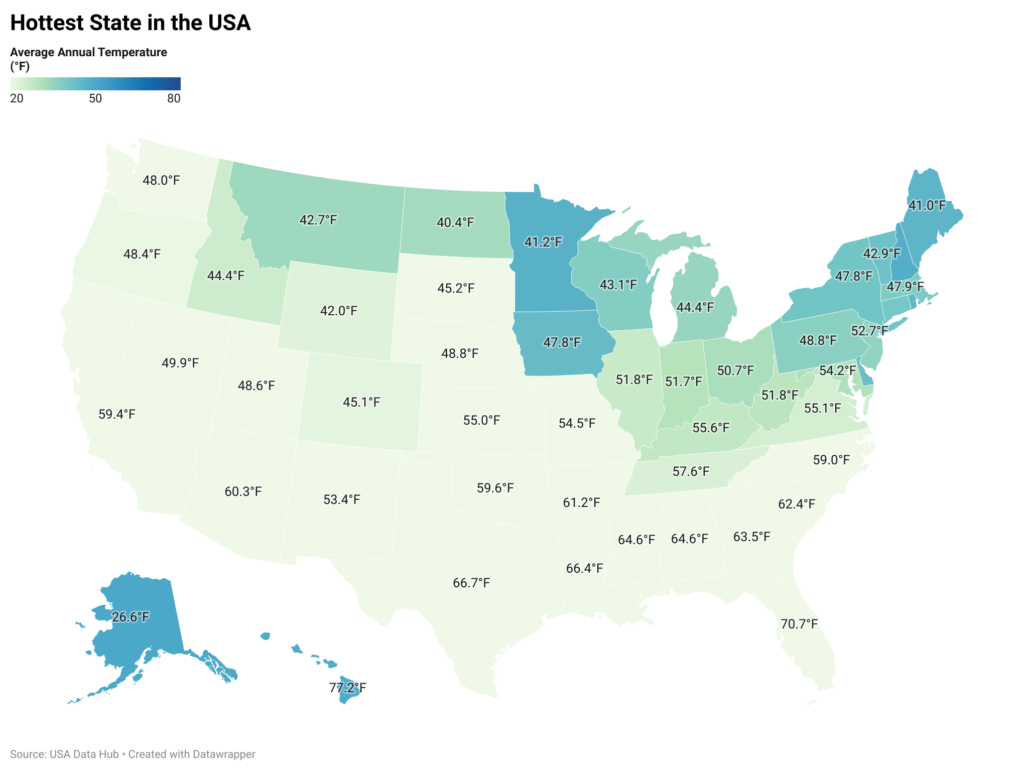Discovering America's Hottest State: Where The Heat Lives
The United States is a land of incredible climatic diversity, boasting everything from the icy expanses of Alaska's tundra to the steamy, subtropical wetlands of Florida. This vast geographical tapestry means that while some regions shiver through harsh winters, others bask in year-round warmth, prompting many to wonder: what truly is the **hottest state in the US**? For those contemplating a move or simply curious about America's most sun-drenched corners, understanding where the heat truly lives is key.
Our quest to pinpoint the hottest state isn't just about finding the highest single temperature ever recorded – though places like Death Valley certainly grab headlines for their scorching extremes. Instead, we're delving into the sustained warmth, the annual average temperatures that define a state's climate, and how these factors influence daily life. Drawing on comprehensive data, including monthly averages from 2022 and observations from 2024, we'll uncover which states consistently rank at the top for heat and what makes their climates so unique.
Table of Contents
- Understanding What Makes a State "Hot"
- Death Valley: A Hotspot, But Not a State
- The Contenders: States Known for Their Warmth
- And The Hottest State Is... Florida!
- The Top 10 Hottest States in the US
- The Impact of Extreme Heat: What to Consider
- Planning Your Move: Heat as a Factor
- Adapting to America's Warmest Climates
Understanding What Makes a State "Hot"
When we talk about the "hottest state in the US," it's crucial to define our terms. Is it about the highest temperature ever recorded? Or is it about the consistent, year-round warmth that characterizes a region? For the purpose of identifying the hottest state, meteorologists and climate scientists typically rely on the mean annual temperature. This metric provides a holistic view, averaging the twelve monthly average temperatures for each state to give a comprehensive picture of its overall warmth throughout the year.Annual Average Temperature: The Primary Metric
The mean annual temperature is arguably the most reliable indicator of a state's general climate. It smooths out the daily fluctuations and seasonal extremes, offering a stable baseline for comparison. For instance, a state might experience a few intensely hot days in summer, but if its winters are significantly colder, its annual average might not be as high as a state that maintains consistently warm temperatures year-round. This is why simply looking at record highs can be misleading when trying to determine the overall warmest state. Data from sources like the National Oceanic and Atmospheric Administration (NOAA) and historical climate records are meticulously compiled to calculate these averages, providing a robust foundation for our rankings.Beyond Averages: The Role of Extreme Heat
While annual averages are key, it's also important to acknowledge that intense summer heat is no stranger in the United States. Every single one of the 50 states has recorded a high temperature of at least 100 degrees Fahrenheit, with many well above 115 degrees. These extreme temperatures, though not factored into the annual mean, certainly contribute to the perception of a state's heat. Southern and western states and cities, in particular, experienced remarkably hot weather in 2024, highlighting that while some states are consistently warm, others face periodic, scorching heatwaves that can be just as impactful on daily life and infrastructure.Death Valley: A Hotspot, But Not a State
Before we crown the hottest state in the US, it's worth addressing a common misconception. When people think of extreme heat in America, Death Valley, California, often comes to mind. And for good reason: it is, after all, one of the hottest places on Earth, holding the record high of 134 degrees Fahrenheit (56.7 degrees Celsius). This California national park is undeniably sweltering, a testament to the planet's capacity for intense heat. However, despite its scorching reputation, Death Valley's extreme temperatures do not make California the hottest state overall. In fact, California isn't even one of the top 10 hottest states in the U.S. This distinction underscores the difference between isolated geographical hotspots and the broad, consistent climate of an entire state. The vast size and diverse topography of the United States mean that while the country is home to some of the hottest places on Earth, it also encompasses some of its coldest, and these variations are often localized within much larger state boundaries.The Contenders: States Known for Their Warmth
The United States has a wide range of climates, from the frozen tundra of Alaska to the everglades of Florida. Most of the hottest states are located in the southern parts of the country, stretching from the southwestern deserts to the shores of the Atlantic Ocean. These regions are characterized by longer summers, milder winters, and often, high humidity. When considering which state has the hottest weather, many might immediately think of Arizona with its scorching deserts, or perhaps Nevada, known for its arid climate. Texas, with its vast size, also comes to mind as a state that experiences significant heat. However, the data reveals a clear frontrunner, consistently ranking as the warmest state year-round.And The Hottest State Is... Florida!
If you've been wondering what state has the hottest weather, you now have your answer. Based on annual average temperature and monthly data from 2022, Florida is unequivocally the hottest state in the US. It consistently ranks overall as the warmest state year-round, a fact supported by decades of climate data.Why Florida Reigns Supreme
Florida's average temperature of 71.5° Fahrenheit sets it apart from all other states. To put this into perspective, Florida is a remarkable 19° warmer than the U.S.'s average temperature of 53°. This significant difference is not just due to hot summers, but a combination of factors that ensure warmth persists throughout the year. While other states might experience extreme summer heat, their annual averages are pulled down by colder winters. Florida, on the other hand, enjoys mild winters that contribute significantly to its high overall mean annual temperature.Florida's Unique Climate Profile
Florida experiences a humid subtropical climate, characterized by hot, humid summers and mild, dry winters. Its peninsula shape, surrounded by the warm waters of the Atlantic Ocean and the Gulf of Mexico, plays a crucial role in moderating its temperatures and maintaining high humidity levels. The consistent warmth of the ocean waters keeps the state from experiencing significant temperature drops, even in the "colder" months. This unique geographical positioning and climatic classification ensure that Florida remains the undisputed hottest state in the US, offering a perpetual summer experience for its residents and visitors alike.The Top 10 Hottest States in the US
While Florida holds the top spot, it's part of a broader group of states that consistently experience high temperatures. Here's a list of the 10 hottest states in the U.S., ranked by their mean annual temperature, which is the average of the twelve monthly average temperatures for each state: 1. **Florida:** Average temperature of 71.5°F 2. **Louisiana:** Following closely, known for its hot, humid climate. 3. **Texas:** A vast state with significant heat, particularly in its southern and western regions. 4. **Arizona:** Famous for its desert heat and extreme summer temperatures. 5. **Mississippi:** Shares a similar humid subtropical climate with its Gulf Coast neighbors. 6. **Hawaii:** While tropical, its consistent warmth places it high on the list. 7. **Alabama:** Another state in the humid subtropical belt. 8. **Georgia:** Experiences hot summers and mild winters. 9. **South Carolina:** Known for its warm coastal areas. 10. **Arkansas:** While not as consistently hot as the top contenders, its summers are long and warm. This ranking is based on comprehensive data, including average temperatures for the year in every USA state, compiled from sources that track monthly climate patterns.A Closer Look at the Southern and Western Heat
It's no surprise that most of these states are located in the southern and southwestern parts of the country. These regions are subject to weather patterns that bring consistent warmth, often coupled with high humidity, especially along the Gulf Coast. The southwestern states, like Arizona and parts of Texas, experience intense dry heat, while the southeastern states, including Florida, Louisiana, and Mississippi, are characterized by a humid subtropical climate that feels equally warm, albeit with higher moisture content in the air. Southern and western states and cities experienced particularly hot weather in 2024, reinforcing their status as America's warmest regions. The map of average summer temperatures for USA states visually confirms this pattern, showing a clear gradient from the warmest states in the south to the coldest in the north.The Impact of Extreme Heat: What to Consider
Living in the hottest state in the US, or any region prone to extreme heat, comes with its own set of considerations. While warm weather can be appealing for outdoor activities and a relaxed lifestyle, prolonged exposure to high temperatures can pose health risks, including heatstroke and dehydration. Infrastructure, too, can be affected, from increased energy demands for air conditioning to potential strain on power grids. For residents, understanding local weather patterns, staying hydrated, and utilizing cooling centers during peak heat waves become crucial aspects of daily life. The economic impact can also be significant, influencing everything from agricultural practices to tourism seasons.Planning Your Move: Heat as a Factor
If you're planning to move somewhere new, summer heat is likely a big factor in your decision-making process. For those who thrive in warmth and sunshine, the hottest states in the US offer an ideal climate. However, for others, the intense heat might be a deterrent, especially if they are accustomed to more temperate zones. Before making a decision, it's wise to consider not just the average annual temperature but also the duration and intensity of the hot season, as well as the humidity levels. Researching specific cities within these states can provide a more granular understanding, as microclimates can exist even within a single state. For instance, coastal areas might offer a sea breeze, while inland regions could be significantly hotter.Adapting to America's Warmest Climates
Living in the hottest state in the US, or any of the consistently warm southern regions, requires a degree of adaptation. This includes adjusting daily routines to avoid the hottest parts of the day, investing in efficient air conditioning, and embracing a lifestyle that often revolves around water activities and indoor cooling. Many homes in these areas are built with features designed to mitigate heat, such as lighter-colored roofs and improved insulation. For those seeking the "ideal places to live" with warm temperate climates in the north and humid subtropical climates in the south, understanding these climatic nuances is essential for a comfortable and healthy life. The diverse geographic characteristics of the country ensure that the climate differs from one shoreline to some other, offering a wide array of choices for every preference.Conclusion
From the sweltering depths of Death Valley to the consistently warm shores of Florida, the United States offers a spectrum of climates. Our journey to identify the hottest state in the US reveals that while many states experience significant heat, Florida stands out with its remarkable annual average temperature of 71.5°F, making it the warmest state year-round. Louisiana and Texas follow closely, cementing the South's reputation as America's heat hub. Whether you're drawn to the perpetual sunshine or prefer to avoid the intense warmth, understanding these climatic differences is crucial for planning your next adventure or even a permanent move. What are your experiences with America's hottest states? Have you visited or lived in Florida, Louisiana, or Texas during their peak heat? Share your thoughts and tips for staying cool in the comments below! If you found this article insightful, consider sharing it with friends or exploring our other guides on diverse U.S. climates.- Xnxnxnxn
- Securely Connect Remote Iot Vpc Raspberry Pi Aws Server
- %E9%87%91%E4%BE%86%E6%B2%85%E8%BF%91%E6%B3%81
- Wisconsin Volleyball Team Leak
- Anissa Kate

The Hottest State Review | Movie - Empire

Hottest temperature ever recorded in each US state... - Maps on the Web

Hottest State In The USA - USA Data Hub